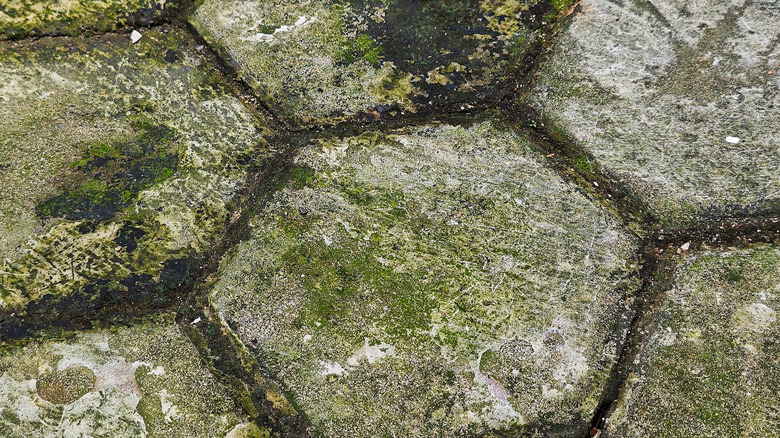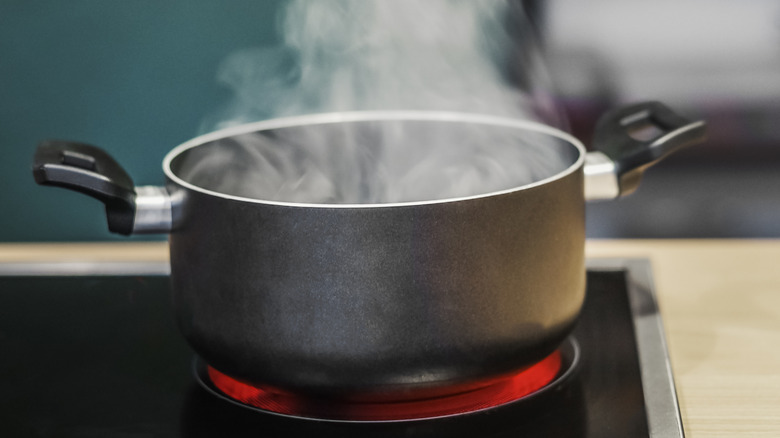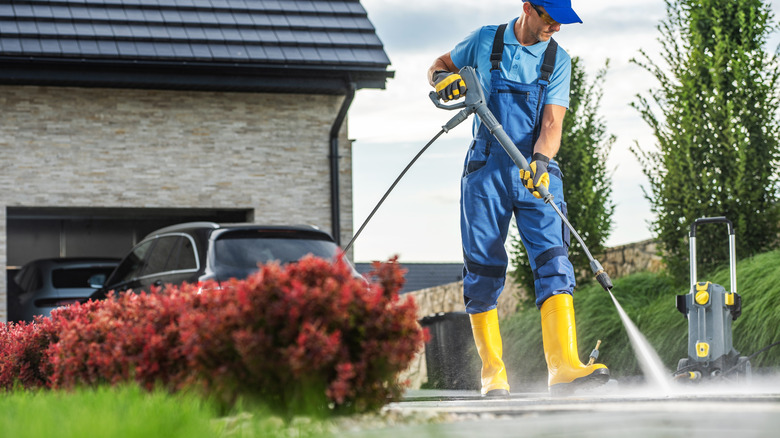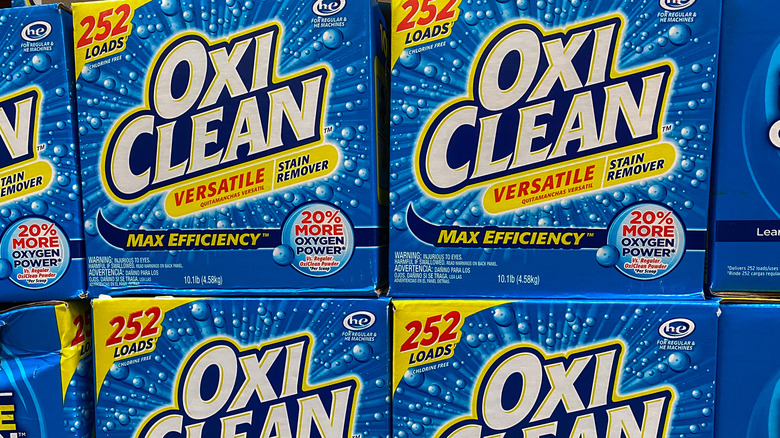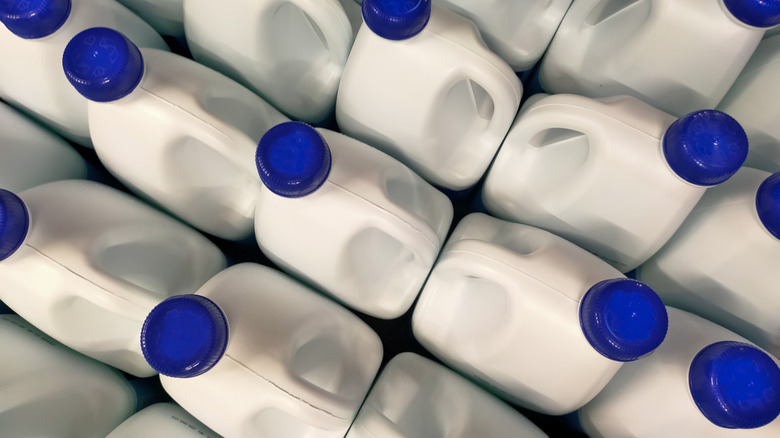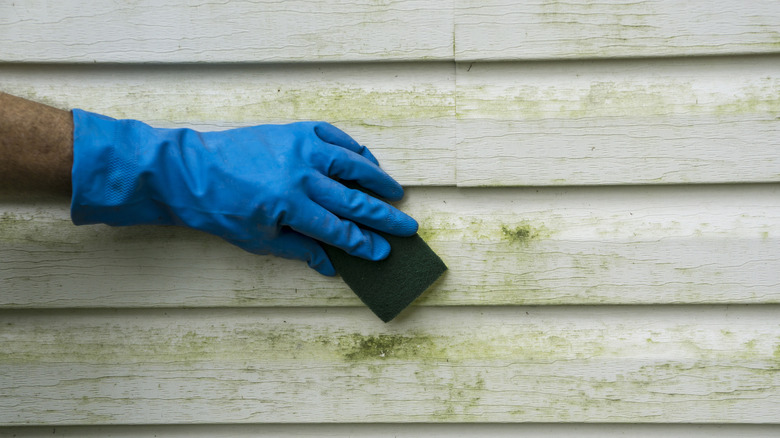Surefire Ways To Banish Green Algae From Concrete And Cement Surfaces
We may receive a commission on purchases made from links.
Nobody likes an uninvited guest crowding up their outdoor spaces, especially when it involves uncontrolled growth. Whether it's an expansive moss overtaking your patio or an untamed hedge crowding up your garden, it can be a hassle to keep your wooden deck or patio grime-free, let alone concrete pavers and driveways. These persistent trespassers can disrupt the natural beauty of your outdoor spaces and can make management feel like a constant battle. But there's one type of growth that particularly stands out for its persistence — green algae. Thriving in shady, moist areas of your garden, algae can quickly turn concrete into slipping hazards, making it not only unsightly but dangerous. It's common for algae to be found around the edge of ponds, clinging to garden paths, and on concrete driveways. Once it starts growing, it seems nearly impossible to remove, creating an uninviting atmosphere around your home.
Luckily, there are a number of ways that you can manage the growth of green algae on your outdoor spaces, ranging from natural remedies to stronger chemical solutions. With a bit of elbow grease and the right solution, you can completely banish green algae from your concrete areas. Whether you're eliminating blooms on the edge of a small pond or transforming a pathway after a particularly rainy season, there is certainly a method that works to banish even the toughest of algae growths.
Pouring boiling water on green algae
The first method of removing green algae from your concrete surfaces involves boiling water. Although it might sound like a simple solution, it is surprisingly effective at removing these small growths. Unlike harsh chemical treatments, boiling water offers an environmentally friendly approach that won't introduce harmful substances into your yard. It can be an extremely effective solution for areas that are near plants, gardens, or ponds, eliminating the potential of contamination. If you're using this method to properly clean a garden pond with wildlife, ensure that there is no risk of them getting hit with boiling water as you clean the algae. With this solution, you should be able to tackle smaller algae growth, but it can be surprisingly effective on larger patches as well.
To employ this technique, you're going to want to boil a pot of water that can completely cover the surface area of your algae growth. For the best results, ensure that the surface is dried out before pouring your water. With your pot, simply pour it over the algae on any surface, ranging from your driveway to small stone paths. Using a stiff, synthetic brush, thoroughly scrub the affected area until you notice that the algae is lifting off the surface. Rinse the area with a garden hose to get rid of any remaining debris and enjoy your algae-free outdoor spaces.
Using a pressure washer on concrete surfaces
If boiling water doesn't seem to do the trick, you can employ the use of a pressure washer as another chemical-free solution. The force of the pressure washer should be enough to blast away any large algae growths without the need for harsh chemicals. To prevent damaging your concrete surfaces, ensure that you are using your pressure washer in accordance with the user manual. Give your concrete a quick test spray to ensure that it does not harm the surrounding areas. In addition to concrete, a pressure washer can be an excellent solution for removing algae off side paneling on your home. Simply spray the growths with the high pressured water, standing a safe distance away from the nozzle. Continue to increase the pressure as necessary in order to properly handle each patch of growth.
Pressure washing not only tackles algae blooms, but it can help remove some of the discoloration caused by their growth. You can also try using a synthetic brush on the stains once the debris has been completely cleared. If your driveway seems to be prone to algae blooms, pressure washing may not be a permanent solution and you might want to try a clear concrete moisture sealant. With recurring growths, you may need to employ stronger chemical solutions to truly eliminate any stubborn stains or algae that might remain on your outdoor surfaces.
Mixing an oxygen bleach solution
Oxygen bleach, like OxiClean, is a gentler alternative to traditional chlorine bleaches, making it a bit safer for removing algae without harming plants or altering the color of your concrete. Although it is possible to scatter dry OxiClean solution on wet concrete surfaces, it is more effective to mix it in a bucket prior to using it. Add four scoops of your cleaning solution to a gallon of water and stir it until the solution dissolves. Sweep your concrete to remove any existing debris before applying the solution with a sponge. Scrub the surface with a large brush and allow it to set for about 30 minutes. The solution shouldn't be completely dried before you wash it off, so it might be advisable to tackle small areas at a time. Rise with a bit of water before moving on to another algae growth.
Not only is this solution effective on algae growths, but it can also help tackle tough stains on your concrete surface. When algae is removed, it often leaves behind a greenish hue on lighter stone surfaces, which can continue to be an eyesore in your outdoor spaces. This mixture can be an excellent way to eliminate some of those stains, as it is even effective on discoloration left by dried leaves. When using this solution, it is best to wear gloves and eye protection to avoid any contact with harsh chemicals.
Applying a strong bleach solution
Chlorine bleach is not as environmentally or plant-friendly as other solutions on this list, but it can be extremely effective at removing stubborn algae growths. It provides a much more aggressive approach that can damage nearby plant life and animals — especially if you're spraying near a pond. It isn't advisable to try this method near small bodies of water. Instead, opt for one of the gentler solutions. But if you need to use this method near any other plants, it is best to spray them with water to proactively dilute any overspray that may occur. This solution can also be extremely harmful to the user, so ensure you're taking the necessary precautions, including wearing old clothes as well as eye and skin protection.
For this solution, add 1/3 cup of bleach to a gallon bucket of water, mixing it thoroughly. Brush the affected area with a large broom in order to remove any surface algae. Before spraying a large portion of your concrete, test it on an inconspicuous spot to ensure that it doesn't damage the surface. If it seems alright, use a sponge or spray bottle to soak the algae growths in your bleach solution, allowing it to sit for around 10 minutes. Rinse the area thoroughly with a bit of water and repeat the steps until you achieve your desired result.
Employ the use of commercial products
If you prefer a hassle-free approach to removing algae growth, commercial algae cleaners might just do the trick. There are a number of products that are specifically designed to remove moss, mold, and algae from various surfaces with minimal effort. Products like the Wet & Forget Moss, Mold, Mildew and Algae Stain Remover may be the most effective option for tackling persistent algae growths and tough stains. They often erode the core of these growths, preventing them from returning. Each individual solution has its own set of instructions, so make sure that you are following them carefully when applying them to any kind of surface.
While these commercial cleaners can be an effective means of removing algae growths, you want to ensure that they are safe to use on your intended surface. Look for cleaners that are labeled safe on concrete before testing them out, as some cleaners may only be effective on certain kinds of outdoor materials. For example, the Wet & Forget is safe for sealed concrete but it does not mention unsealed concrete. There are a number of products that can bring your stained concrete back to life, so ensure that they are meant for use on your outdoor surfaces. Before their use, read each label so that your outdoor surfaces remain intact. With a bit of regular use, the cleaners can work wonders at preventing algae growth on a number of surfaces.
